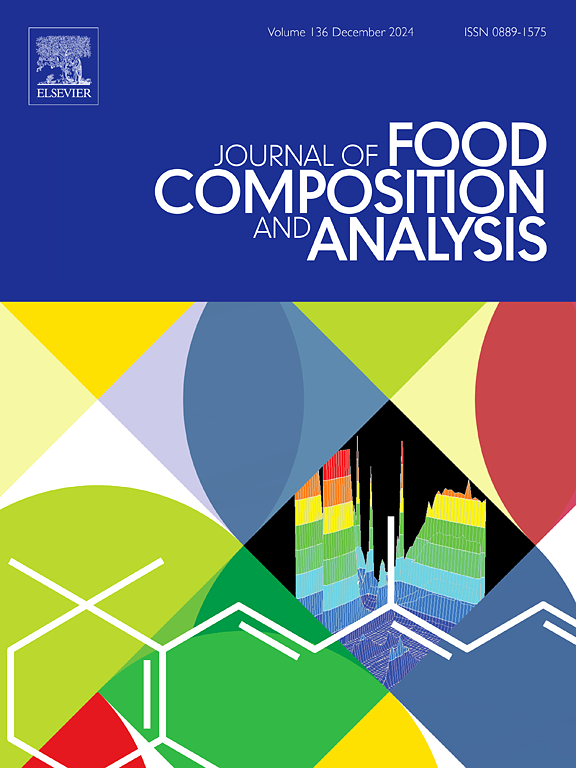通过 GC-FID 方法分析乳制品中的脂肪酸:利用 PS/SNW-1 纳米纤维增强 PT-µSPE
IF 4
2区 农林科学
Q2 CHEMISTRY, APPLIED
引用次数: 0
摘要
为了快速、同时测定乳制品中的多种脂肪酸,一种新开发的基于聚苯乙烯/席夫碱网络-1(PS/SNW-1)电纺纳米纤维的吸附剂被用于吸头-微固相萃取(PT-µSPE)和气相色谱-火焰离子化检测器(GC-FID)。PS 具有多孔性和疏水性,而 SNW-1 是一种共价有机框架,在水溶液和酸性溶液中具有强大的耐受性、可接受的热稳定性、可观的比表面积和累积的 π 电子系统,从而提供了一种具有卓越萃取效率的吸附剂。在最佳条件下,肉豆蔻酸的线性动态范围为 0.3-30000 µg L-1,棕榈酸为 0.3-45000 µg L-1,硬脂酸和油酸为 6.0-60000 µg L-1。此外,该方法的检出限(LOD ≤ 1.8 µg L-1)和定量限(LOQ ≤ 6.0 µg L-1)较低,日内分析的相对标准偏差在 1.19-5.59 % 之间,日间分析的相对标准偏差在 2.83-5.93 % 之间。此外,相对回收率和吸附剂重复利用率也令人满意。本文章由计算机程序翻译,如有差异,请以英文原文为准。
Fatty Acids Analysis in Dairy Products via GC-FID Methodology: Leveraging PS/SNW-1 Nanofibers for Enhanced PT-µSPE
In an effort for rapid and simultaneous determination of multiple fatty acids in dairy products, a newly developed sorbent based on polystyrene/Schiff base network-1 (PS/SNW-1) electrospun nanofibers were used for pipette tip-micro solid phase extraction (PT-µSPE) with gas chromatography-flame ionization detector (GC-FID). The porous and hydrophobic nature of PS, in the presence of the SNW-1 as a covalent-organic framework with robust resistance in aqueous and acidic solutions, acceptable thermal stability, a substantial surface area, and an accumulated π-electron system, offers a sorbent with exceptional extraction efficiency. This innovative approach overcomes the limitations encountered when utilizing SNW-1 and PS individually, such as back pressure, leakage, and limited reusability.Under optimum conditions, an outstanding linear dynamic range was obtained in the range of 0.3–30000 µg L−1 for myristic acid, 0.3–45000 µg L−1 for palmitic acid, and 6.0–60000 µg L−1 for stearic acid and oleic acid. Additionally, the method demonstrated a low limit of detection (LOD ≤ 1.8 µg L−1) and limit of quantification (LOQ ≤ 6.0 µg L−1), along with relative standard deviations within the range of 1.19–5.59 % for within-day and 2.83–5.93 % for between-day analyses. Furthermore, satisfactory relative recovery and sorbent reusability were also achieved.
求助全文
通过发布文献求助,成功后即可免费获取论文全文。
去求助
来源期刊

Journal of Food Composition and Analysis
工程技术-食品科技
CiteScore
6.20
自引率
11.60%
发文量
601
审稿时长
53 days
期刊介绍:
The Journal of Food Composition and Analysis publishes manuscripts on scientific aspects of data on the chemical composition of human foods, with particular emphasis on actual data on composition of foods; analytical methods; studies on the manipulation, storage, distribution and use of food composition data; and studies on the statistics, use and distribution of such data and data systems. The Journal''s basis is nutrient composition, with increasing emphasis on bioactive non-nutrient and anti-nutrient components. Papers must provide sufficient description of the food samples, analytical methods, quality control procedures and statistical treatments of the data to permit the end users of the food composition data to evaluate the appropriateness of such data in their projects.
The Journal does not publish papers on: microbiological compounds; sensory quality; aromatics/volatiles in food and wine; essential oils; organoleptic characteristics of food; physical properties; or clinical papers and pharmacology-related papers.
 求助内容:
求助内容: 应助结果提醒方式:
应助结果提醒方式:


